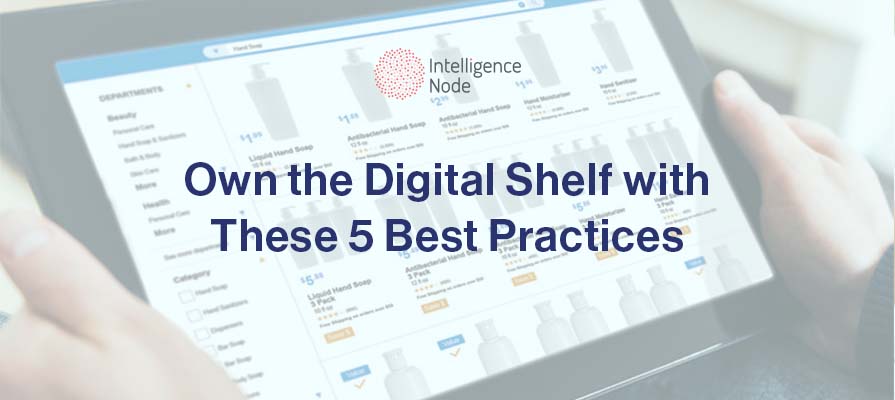What is the Digital Shelf and Why Do You Need to Optimize it?
The Digital Shelf is the online counterpart of product aisles that you see in brick-and-mortar departmental stores or supermarkets. When browsing through these stores, you mostly buy products that are at your eye level over the ones displayed at the bottom or top aisle or somewhere at the corner of the store. Similarly, the digital shelf is any online touchpoint where customers might find your products. These include your website, Google/Bing search results, third-party websites, and marketplaces where your products are sold.
Like with physical stores, you need to be visible to your shoppers online so they can choose your products over your competitors. And for that you need to appear on the first page of the digital shelf and search results. But it is not as easy as it sounds. To rank higher on the digital shelf, you need to review and consider multiple parameters – product descriptions and imagery, assortments and product availability, customer reviews and ratings, competitor prices, etc. You need to constantly monitor, review, and optimize these parameters to improve your digital shelf performance and your conversions.
The Fight for Customer’s Attention has Intensified
The COVID-19 pandemic has changed the face of retail forever. eCommerce quickly took the center stage as the pandemic coaxed more brands and retailers to move online or take the omnichannel route. The number of online stores grew rapidly and with it, the competition to get in front of shoppers intensified. In 2020, there were over 24 million online stores, all fighting for the attention of the same shopper. With so much background noise, relying on your unique products alone won’t suffice if they are not visible to the shoppers. It is time brands bring out the big guns to stand out and get their customers’ attention. And how can they achieve this? With Digital Shelf Analytics!

How Brands can Leverage Digital Shelf Analytics to Improve Conversions
The first step in ensuring your customers find you is by appearing on top of search results. In fact, moving from page 2 to page 1 can boost your sales by almost 20x. Making digital shelf visibility an extremely important factor in ensuring high conversion rates.
Your digital shelf performance comprises multiple parameters and any one or more of the following factors can affect its performance:
- If your product descriptions are inaccurate or insufficient
- If your customer reviews and ratings are poor
- If your products go out of stock
- If the images in your product listings are unclear or missing
- If your products cost more than competing products
- If you don’t have the right breadth of assortment
Any of these factors could bring down your online visibility and directly impact your sales. Hence, it is crucial to place digital shelf optimization at the heart of your eCommerce strategy. With advanced digital shelf analytics, brands and retailers can have real-time visibility into digital shelf performance. The right technology could help you alter your strategy to beat the competition and emerge at the top. You need to find a solution that is easy and quick to integrate and provides fast and accurate actionable insights that deliver results.
5 Best Practices to Address Key Digital Shelf Challenges
-
#1 . Digital Shelf Challenge – Product is not visible on the 1st page of search or the digital shelf
Almost 90% of online inquiries start with a search. Most shoppers don’t look past page 1 anymore, and almost 80% only look at the first five rows. Hence, if your products are not ranking on page 1 of search or the digital shelf, you are mostly losing your customers to your competitors. To improve conversions, you need to make it easy for your customers to find you. And with the right tools, you can do just that!
-
Best Practice – Optimize your online visibility for improved search rankings
1st page visibility is critical as it builds credibility and trust. With advanced digital shelf analytics, easily track your rankings, compare them with competitors, and optimize listings to rank higher on search engines. Analyze what is working for your competitors and optimize your listings accordingly with the right keywords, attributes, and prices. This will together result in improved visibility.

-
#2. Digital Shelf Challenge – Product is unavailable or out of stock
You have the consumer’s attention, they have looked at your terrific product page and they click on the link to “buy” the product and all of sudden the “out of stock” message pops up. You now have a frustrated consumer who you’ve driven to your competitor’s website.
Out of stock products are a major turn off for shoppers and alienate them from a brand. It is also a big loss for the brand or the retailer as you are essentially turning down a customer who is ready to buy a product from you. As out of stock or over stocking of products is a common problem haunting retailers, finding a data-driven solution is the best bet to solve this digital shelf challenge.
-
#3. Digital Shelf Challenge – Incomplete, incorrect or missing product copy & images
To improve your search rankings and visibility requires more than just good products or competitive pricing. Although these two factors are important, your product descriptions, SEO keywords, and quality images significantly contribute to ensuring your products are visible on the first page. Infact, 30% of shoppers abandon their shopping carts due to inaccurate product descriptions.
The reality is that consumers shop online because:
1) they believe they can get a better price and
2) they think they can conduct better research into the product features
So, if your product descriptions are not comprehensive, your consumers will move to the other brands that have more complete information. Let’s try to address this challenge of digital shelf.
-
Best Practice- Include detailed descriptions and high quality product images
Brands and retailers need to spend time and effort in ensuring that their product copy and listings are comprehensive and accurate. With smart digital shelf analytics, they can identify the right keywords to use and enrich their copy with key attributes. They can track competitor rankings and optimize their content by including similar keywords to improve visibility and provide the right descriptions to aid conversions. With Intelligence Node’s product improvement score, retailers and brands can analyze their product performance and improve it immediately.
Parameters Definitions Product code: 80050312 Example score calculations 1) Attribute coverage Number of attribute details available, out of the total number of attributes for the product (category specific). Attribute coverage < 50% results in “failed” coverage (score =1) 17% (assume) Failed = 1 2) Image count Image count < 3 results in “failed” coverage (score =1) 2 Failed = 1 3) Image quality Image quality < median results in “failed” coverage (score =1). The highest image pixel count for every product has been considered in calculating the median of image quality assume 226000 (median = 395875) Failed = 1 4) Length of product info Length of product info < results in “failed” coverage (score =1). The total character count of the product info has been considered for calculating the median of the length assume 409 (median = 626) Failed = 1 Total 4 -
#4. Digital Shelf Challenge – Poor visibility into consumer reviews
Consumers often rely on customer reviews to give them an indication of the experience they might get with the product or the store. Poor consumer reviews can have a direct impact on your conversions and brand identity. A product with more than 5 reviews has a 270% higher chance of being purchased. On the other hand, products without reviews or with poor reviews can discourage shoppers from buying your product and can have a huge impact on consumer sentiment about your products.
-
Best Practice – Listen to what is working for your customers
Consumer reviews are insightful and give you a peek into their sentiments about your product. However, the trend is that most retailers are not tracking customer reviews, much less negative reviews. Lack of visibility to negative customer reviews can severely impact customer’s perception of the brand and the product. Brands and retailers should use customer reviews to improve their product features and attributes. They can leverage user-generated keywords into their product copies to resonate better with their customers. With a ‘rating dashboard’, get an overview of how consumers perceive and rate your products in a summary form and drill down further to any category, brand, or competitor.

Intelligence Node Product Screenshot -
#5. Challenge – No real-time assessment of competitive pricing
In today’s highly competitive eCommerce environment, price remains the most popular reason why shoppers select a product. Sophisticated players like Amazon review their pricing every 2 minutes to ensure they are strategically priced. And without visibility into competitor prices, brands and retailers can lose sales owing to overpriced products or lose margins by underpricing their products. They might also leave money on the table in the absence of a robust pricing strategy in place.
-
Best Practice – Offer competitive prices by optimizing and reviewing online prices to improve digital shelf performance
When selling online, you are competing with players like Amazon and Walmart, who review their prices multiple times a day. Hence, your pricing strategy needs to be agile and dynamic to keep up with price changes and comparison shoppers. You need to track competitor prices in real-time and have an automated price optimization strategy to take advantage of any pricing or assortment gaps left by competitors. Ensure your pricing tools are equipped to offer accurate price recommendations based on multiple factors like competitor prices, market trends, demand, product visibility, etc. Compare and benchmark against exact and similar competitor products with advanced pricing solutions to improve performance on the digital shelf.
Best Practice – Maintain optimum inventory levels of all products to achieve success on the Digital shelf
Deciding the inventory levels for your SKUs cannot be based on product forecasts alone. You need comprehensive data analytics to understand actual day-to-day demand for top-selling products, the short-term impact of seasonal trends, and real-time competitor sales. Once you have current and historical data, you can predict demand and sales velocity and accordingly optimize your stock levels to ensure you are neither over stocked nor under stocked. You can make sure you have inventory when the customer wants to buy; and you can also take advantage of the market if your competitors don’t have inventory.

It’s Time to Own The Digital Shelf
It’s no secret that brands and retailers that leverage technology for customer and competitor data move ahead in the eCommerce race. Amazon, Walmart, and Target are examples of retailers harnessing data and analytics to win the retail race. Digital Shelf is one such area that is less explored but fast gaining the importance it deserves. Brands and retailers need to invest in advanced digital shelf analytics to stay ahead of the curve and thrive in the evolving retail space.
Intelligence Node’s Digital Shelf Analytics Software is powered by proprietary AI and offers real-time insights into your digital shelf performance with 99% accuracy. Book a Demo.





